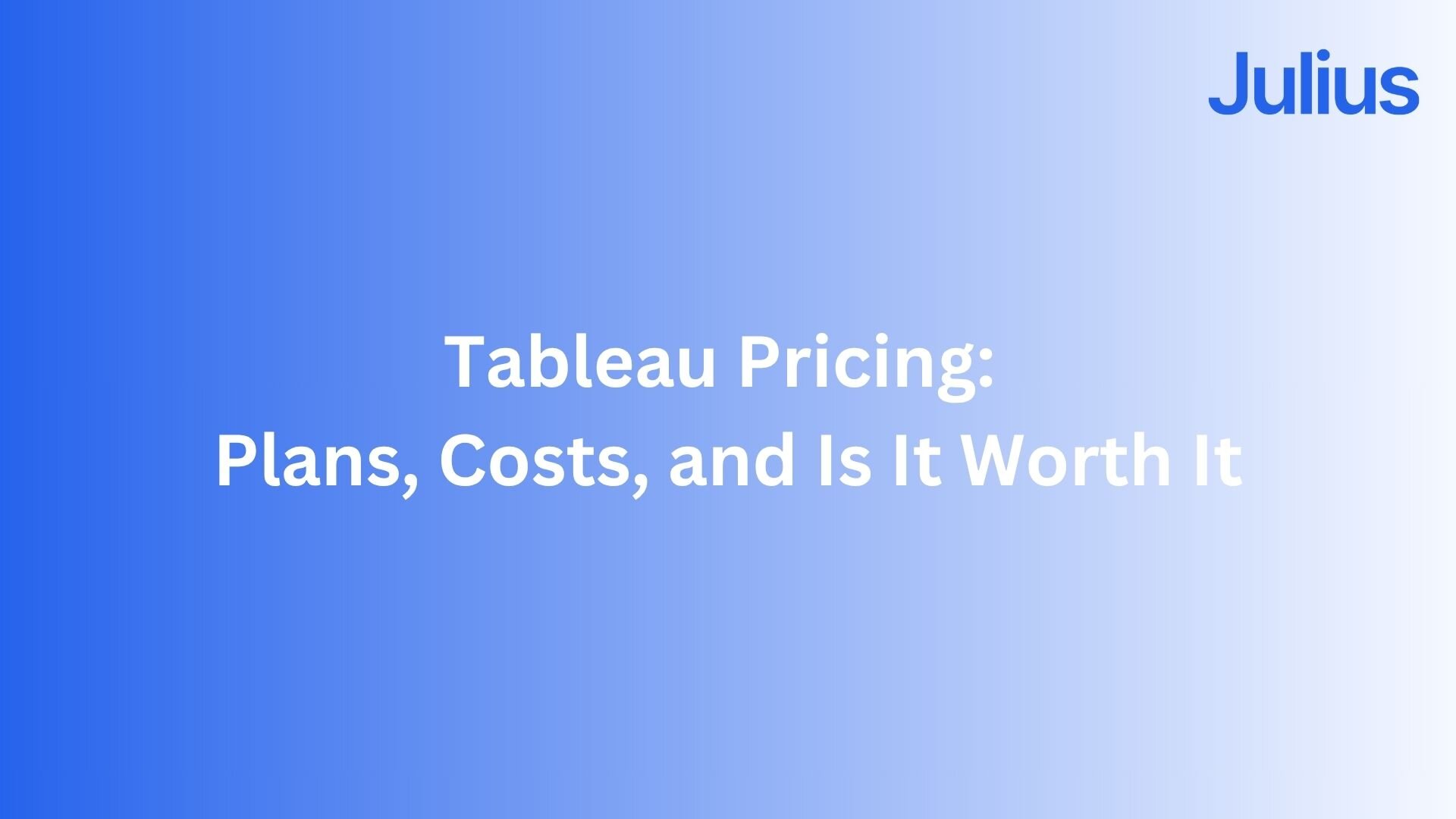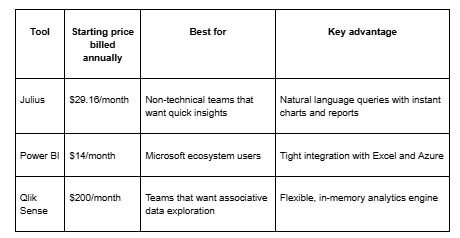October 3rd, 2025
Tableau Pricing: Plans, Costs, and Is It Worth It in 2025?
By Zach Perkel · 21 min read

Tableau pricing for Cloud plans starts at $15 per user per month for Viewer, $42 for Explorer, and $75 for Creator (billed annually). These are the standard subscription rates, while Tableau Server adds extra infrastructure costs and may have minimum user counts.
I’ve tested Tableau across different setups, and the real challenge is understanding how costs stack when you mix license types or deploy Tableau Server with its extra infrastructure expenses.
In this article, we’ll cover:
Tableau pricing at a glance
Enterprise pricing
Tableau Cloud vs Tableau Server
Tableau alternatives
Tableau pricing plans: at a glance
Tableau offers three main subscription tiers that scale by features and user roles. Here are the prices and what each includes:
License | Price per user/month (billed annually) | Best for | Key features |
|---|---|---|---|
Creator | $75 | Analysts and data creators | Full authoring, data prep, Tableau Desktop, and Tableau Prep Builder |
Explorer | $42 | Business users who explore and build dashboards | Web authoring, dashboard creation, and limited prep |
Viewer | $15 | Teams that only view dashboards | View and interact with dashboards, mobile access, alerts, and subscriptions |
Creator: $75 per user per month
What’s included: Tableau Desktop, Tableau Prep Builder, full authoring, and data prep
Best for: Analysts or advanced users building dashboards and prepping data
Pros: Full feature access, extra licenses included
Cons: Every deployment requires at least one Creator license, which means you can’t avoid that $75 per user cost. As your team expands, adding more creators means the cost rises higher
Viewer: $15 per user per month
What’s included: Dashboard viewing, mobile access, alerts, subscriptions
Best for: Teams that only need to view dashboards
Pros: Affordable entry point, easy mobile access
Cons: Viewers can’t create or edit dashboards, so you need enough Creators or Explorers on your team to produce the content they’ll use
Tableau Enterprise pricing
Tableau Enterprise pricing builds on the standard Creator, Explorer, and Viewer licenses with added management, governance, and data tools. These plans are billed annually per user:
Enterprise Creator: $115 per user/month, includes Tableau Desktop, Tableau Prep Builder, advanced management features, and eLearning access
Enterprise Explorer: $70 per user/month, includes web authoring, advanced data management, Tableau Pulse, and eLearning access
Enterprise Viewer: $35 per user/month, includes dashboard viewing with enterprise-grade data management and Tableau Pulse
These prices are for Tableau Cloud. Tableau Server customers pay the same subscription rates but also cover their own infrastructure, IT staff, and maintenance.
From what I’ve seen, enterprise pricing matters most for larger organizations that need stricter compliance, detailed governance, and Tableau Pulse. For smaller teams, the standard Creator, Explorer, and Viewer licenses are usually enough without the enterprise layer.
Tableau Cloud vs Server pricing
Tableau Cloud and Tableau Server have similar per-user subscription fees, but Tableau Server requires at least one Creator license and a 100-user minimum for Viewer or Explorer roles. This makes Server more expensive than Tableau Cloud. On top of the license fees, Server deployments add costs for on-premises hardware, IT support, and ongoing maintenance.
Tableau Cloud includes hosting and updates in the subscription, so your spend stays closer to the published license fees. For most teams, Cloud is the simpler and more affordable option, while Server fits organizations that need strict control for security or compliance reasons.
Which Tableau plan should you choose?
Tableau plans work best when matched to your team’s roles and how much editing or data prep you need. The right plan depends on whether you’re creating dashboards, exploring data, or just viewing reports.
Choose Creator if you:
Build dashboards or run advanced data prep jobs
Need full desktop tools like Tableau Desktop and Prep Builder
Choose Explorer if you:
Manage business reporting but don’t need heavy data prep
Want to edit and create dashboards directly in the browser
Choose Viewer if you:
Only need to view dashboards and track results
Work in a larger team supported by Creators or Explorers
Choose Tableau Enterprise plans when:
You need advanced management, compliance, and governance tools
Your organization benefits from features like Tableau Pulse and eLearning access for larger teams
Is Tableau worth the cost?
Tableau’s cost is justified if your team needs powerful dashboarding and data visualization across different departments. I’ve used it in settings where analysts built complex dashboards once and then shared them with hundreds of business users, and in those cases, the subscription price paid off.
It’s worth it if: You want a platform that scales across departments and gives both analysts and business users access to the same dashboards.
It’s best for: Larger organizations that need governance, role-based access, and strong visualization tools all in one place.
Skip it if: You’re a small team that only needs light reporting or basic charts. In that case, simpler and cheaper tools like Google Data Studio or even Excel may cover your needs without the higher cost of Tableau licenses.
Tableau alternatives and pricing comparison
Tableau isn’t the only option for data analysis and visualization. Other platforms cover similar jobs, often with different pricing models and features. I’ve compared a few of the main alternatives below so you can see how they stack up on costs, use cases, and strengths.
Let’s take a look at some Tableau competitors:

Julius vs Tableau: Which should you choose?
Tableau is a leading BI tool that delivers strong dashboards, permissions, and enterprise integration. It’s powerful for analysts and large companies, but the tradeoff is a learning curve, higher license costs, and added overhead with Server.
Julius offers a simpler path. You connect your data, ask questions in plain English, and get quick charts or reports. Julius’ pricing is straightforward, with a free forever plan and paid plans starting at $29.16 per month.
Here’s how to choose:
Julius is better for: Non-technical teams that want to ask questions in plain language and get quick reports without worrying about queries or credits.
Tableau is better for: Data engineering and analytics teams that need full control of data models, advanced visualizations, and enterprise governance.
Use both if: You want to keep Tableau as your main warehouse-backed BI system while giving business users an easier analysis layer in Julius.
Ready to simplify your analysis and costs? Try Julius for free today.
My bottom line on Tableau pricing
Tableau is a strong option if your team needs enterprise-grade dashboards and governance across multiple departments. I’ve seen it shine in larger organizations where analysts build complex reports that hundreds of people rely on every day.
The challenge is that Tableau’s cost rises quickly as you add users, and running it on Server adds even more overhead. This tracks when I look at other Tableau reviews, which tend to echo the same sentiment.
I see more value in tools like Julius if you want to avoid complexity, since it doesn’t require mixing license types or hitting user minimums. It avoids the steep learning curve and lets business users work with data directly, without depending on analysts or IT.
Frequently asked questions
What is the cheapest Tableau plan?
How much does Tableau cost per user?
Clustering and segmentation
Tableau has long supported clustering with methods like k-means, and 2025 updates expand this through AI-driven workflows. Embedded models now automate segment creation with minimal setup, and adaptive clustering re-groups records as data changes.
Business users can also refine or split clusters in visual dashboards, reuse segmentation rules, and publish results to Tableau Cloud with built-in explainability reports.
Is Tableau free to use?
No, Tableau is not fully free, but it offers a 14-day free trial of its core products and a free version called Tableau Public for creating visualizations that are shared publicly. The trial gives you access to premium features before you buy, while Tableau Public is limited and not suitable for private business data.
Is Tableau the same as product analytics tools?
No, Tableau is not the same as product analytics tools because Tableau focuses on dashboards and reporting, while product analytics tools measure user behavior, feature adoption, and in-product engagement.
